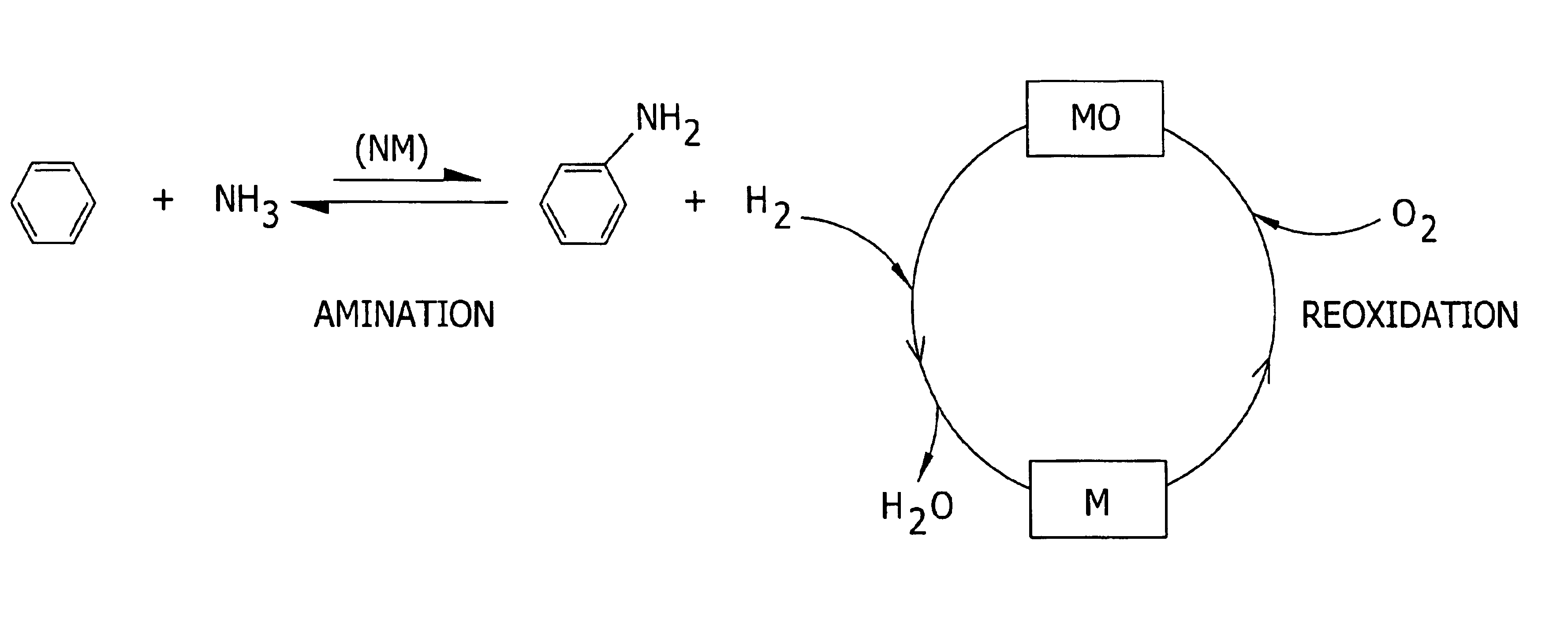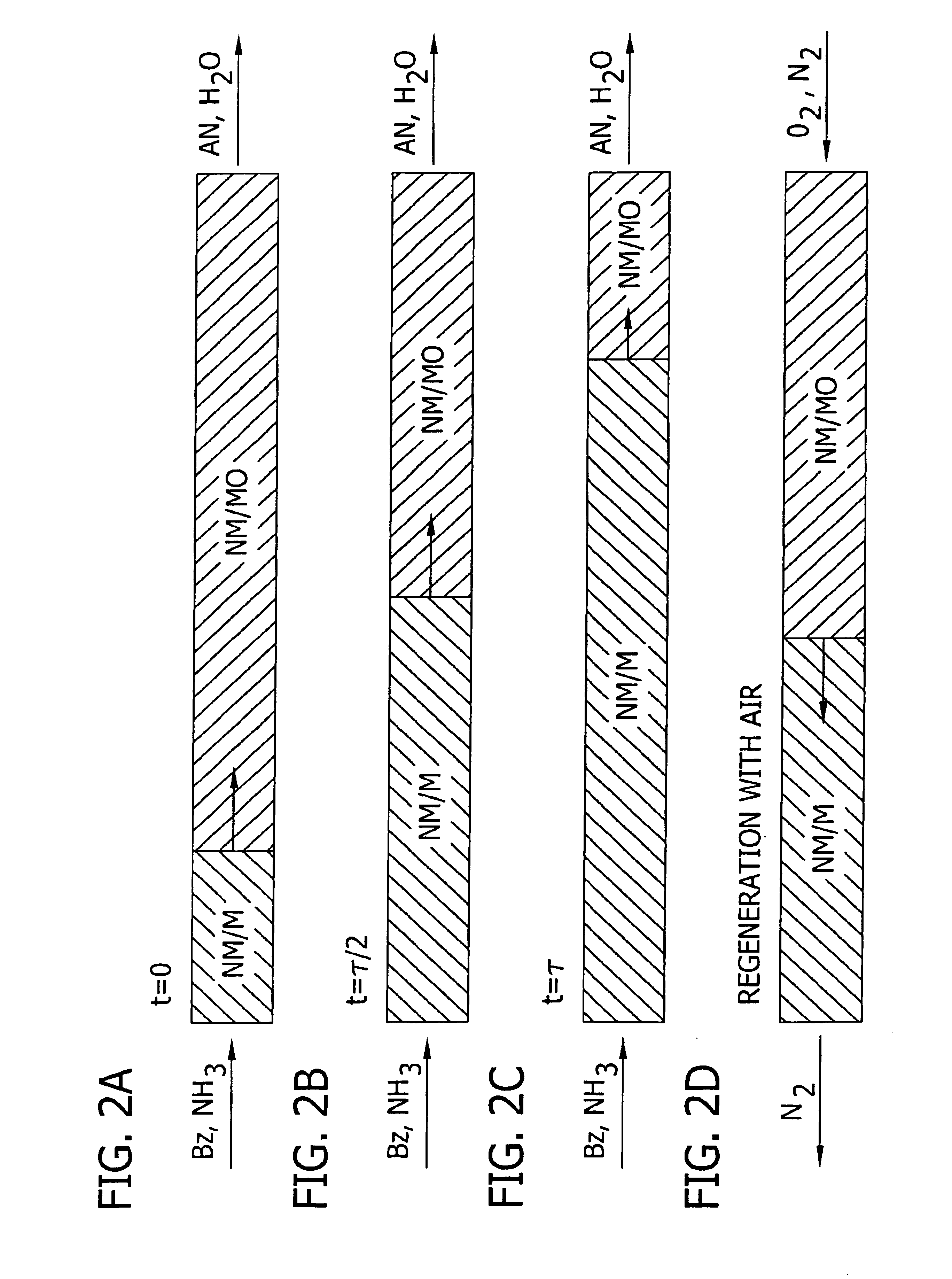Amination of aromatic hydrocarbons and heterocyclic analogs thereof
a technology of aromatic hydrocarbons and heterocyclic analogs, which is applied in the preparation of amino compounds, organic chemistry, chemistry apparatus and processes, etc., can solve the problems of corrosive material handling, environmental and/or feedstock cost concerns, and reaction i is, however, thermodynamically disfavored in the forward direction at reasonable temperatures and pressures, and the approach of direct, single-step amination of benzene to aniline has not been adopted commercially. achieves high level
- Summary
- Abstract
- Description
- Claims
- Application Information
AI Technical Summary
Benefits of technology
Problems solved by technology
Method used
Image
Examples
example 1
Preparation of Aniline with Rhodium-Based Cataloxidants
[0148]This example demonstrates the synthesis of a Rh / Ni-oxide / Mn-oxide / ZrO2 catalyst (Example 1A), a Rh / Ni-oxide / ZrO2 catalyst (Example 1B), a Rh / Ni-oxide / Mn-oxide / KTiO2 catalyst (Example 1C), and a Rh / Co-oxide / ZrO2 catalyst (Example 1D), as well as the use thereof for the direct amination of benzene to aniline. Effective regeneration of some of these rhodium-based catalyst is demonstrated below (See Example 6A through 6C).
example 1a
Rh / Ni-oxide / Mn-oxide / ZrO2
[0149]A Rh / Ni-oxide / Mn-oxide / ZrO2 catalyst was prepared as follows. A zirconia support (⅛ inch pellets, surface area 54.1 m2 / g, pore volume 0.3 cc / g, Norton Chemical Process Products Corp., Product No. XT 16075) was pre-calcined at 110° C. for 1 hour. The zirconia support (30 g) was impregnated with an aqueous precursor solution comprising nickel nitrate, manganese nitrate and rhodium nitrate. The precursor solution was formed by combining Ni(NO3)2.6H2O (22.3 g), Mn(NO3)2.x H2O(1.466 g), rhodium (III) nitrate solution (1.064 ml, 10% wt / wt Rh), and distilled water (I ml), and slowly warming to facilitate dissolution. When a clear solution was obtained, the pellets were impregnated with the solution in two steps with an intermediate drying step (100° C., 2-3 h), resulting in complete absorption of the precursor solution by the pellets. The impregnated pellets were then dried at 110° C. for 6 hours. The temperature of the oven was then raised to 450° C. in an ...
example 1b
Rh / Ni-oxide / ZrO2
[0151]Stock solutions used for catalyst preparation were prepared as follows. A Ni(NO3)2 solution was prepared by dissolving Ni(NO3)2.6H2O (97.3130 g) into water to make 500 ml solution (hereinafter referred to as the “Ni(NO3)2 Solution A”). A rhodium (III) solution was prepared by dissolving Rh(CH3COCH═C(O)CH3)3 (4.0100 g) into acetic acid to make 200 m solution (hereinafter referred to as the “Rh(III) Solution”).
[0152]A Rh / Ni-oxide / ZrO2 catalyst was prepared as follows. Zr(OC3H7)4 / HOC3H7 (70 wt %, 8.300 ml) was mixed with 5.0 ml distilled water at room temperature while stirring. After hydrolysis, the sample was dried at 110° C. for 5 hours to form a support material. The Ni(NO3)2 Solution A (15.0 ml) was combined with the support material, and the mixture was stirred, and then dried at 110° C. for 5 hours. Acetic acid (10 ml) and the Rh(III) Solution (1.800ml) were then added. The sample was dried at 110° C. for 5 hours, and then calcined in air at 450° C. for 4 ...
PUM
 Login to View More
Login to View More Abstract
Description
Claims
Application Information
 Login to View More
Login to View More - R&D
- Intellectual Property
- Life Sciences
- Materials
- Tech Scout
- Unparalleled Data Quality
- Higher Quality Content
- 60% Fewer Hallucinations
Browse by: Latest US Patents, China's latest patents, Technical Efficacy Thesaurus, Application Domain, Technology Topic, Popular Technical Reports.
© 2025 PatSnap. All rights reserved.Legal|Privacy policy|Modern Slavery Act Transparency Statement|Sitemap|About US| Contact US: help@patsnap.com



